Stord
| Country | Norway |
| Ship Class | S-class Destroyer |
| Hull Number | G26 |
| Builder | J. Samuel White, Isle of Wight, United Kingdom |
| Laid Down | 25 Feb 1942 |
| Launched | 3 Mar 1943 |
| Commissioned | 26 Aug 1943 |
| Displacement | 1,740 tons standard; 2,570 tons full |
| Length | 363 feet |
| Beam | 36 feet |
| Draft | 15 feet |
| Machinery | Parsons geared steam turbines with two screws |
| Power Output | 40,000 shaft horsepower |
| Speed | 36 knots |
| Range | 4,675nm at 20 knots |
| Crew | 170 |
| Armament | 4x120mm Mark XII dual-purpose guns, 1x40mm twin Bofors guns, 4x20mm twin Oerlikon guns, 2x4x21in torpedo tubes, 4x throwers and 2x depth charge racks |
Contributor: David Stubblebine
ww2dbaseIn Feb 1942, the shipyards of J. Samuel White on the Isle of Wight, England, United Kingdom laid down a S-class destroyer as the HMS Success. While under construction in 1943, the ship was transferred to the Norwegian Government in Exile and renamed HNoMS Stord, after a large island in southwestern Norway. Stord was commissioned on 26 Aug 1943 with Lieutenant Commander Skule Storheill in command. LtCdr Storheill had previously commanded the destroyer escort HNoMS Eskdale, which was sunk in the English Channel 14 Apr 1943. Many of the Eskdale's surviving crew also became part of the Stord's crew.
ww2dbaseAfter a brief shakedown period, Stord began escort duties for convoys on the Arctic route. Almost right away in Dec 1943 the Stord was tested as she found herself in the middle of the Battle of the North Cape. During a coordinated flanking attack with British cruisers and destroyers, Captain Storheill pressed his attack against the German battlecruiser Scharnhorst by closing to within 400 yards before launching his torpedoes, scoring hits on Scharnhorst's starboard side.
ww2dbaseStord's actions were singled out for praise by Admiral Bruce Fraser, overall British commander in the engagement, who included in a message to the Admiralty, "Please convey to the C-in-C Norwegian Navy: Stord played a very daring role in the fight and I am very proud of her." The Captain of the British flagship, Duke of York, said, "The Norwegian destroyer Stord carried out the most daring attack of the whole action."
ww2dbaseStord continued with her Arctic convoy escort duties until May 1944 when she was chosen for an assignment in the upcoming Normandy operation off France. Stord was to be one of the escorts for British battleships Warspite and Ramillies and the cruiser Mauritius. Stord was also assigned, along with Royal Navy destroyer Scorpion, to bombard the Normandy town of Ouistreham ahead of the landings on Sword Beach and to provide naval gunfire support during assault. Later in the month, Stord engaged German ships trying to evacuate German forces out of Cherbourg.
ww2dbaseStord suffered minor damage off Cherbourg when a mine exploded near her stern that caused her to put into Portsmouth, England for repairs. Stord then resumed her Arctic convoy escort duties which occupied her through to the end of the war, except for another brief refit in Feb 1945 on the River Tyne in England.
ww2dbaseAfter Germany's surrender, Stord was among the ships assigned to intercept surrendering German U-Boats in the North Sea. Then in June 1945, Stord escorted British cruiser HMS Norfolk as Norfolk carried Norway's King Haakon VII back to Norway after five years in exile in the United Kingdom.
ww2dbaseIn 1946, the Norwegian government formally purchased the Stord and she served in the Norwegian Navy until 1959, when she was decommissioned and scrapped.
ww2dbaseSources:
Naval History (UK)
UBoat.net
Trygve Hansen Oral History
World War II Today
Wikipedia
Last Major Revision: Jun 2016
Destroyer Stord (G26) Mapa Interativo
Photographs
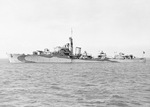 | 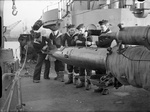 | 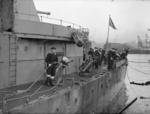 | 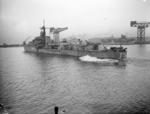 |
Maps
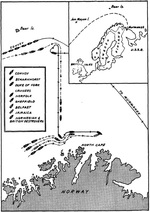 |
Stord Operational Timeline
| 25 fev 1942 | The keel of destroyer Success was laid down by J. Samuel White on Isle of Wight, England, United Kingdom. |
| 3 mar 1943 | Destroyer Stord was launched on Isle of Wight, England, United Kingdom. |
| 26 ago 1943 | Destroyer Stord was commissioned into service with Lieutenant Commander Skule Storheill in command. |
| 26 dez 1943 | Norwegian destroyer Stord closed to within 400 yards of the German battlecruiser Scharnhorst to fire a spread of torpedoes at Scharnhorst's starboard side. |
| 6 jun 1944 | Norwegian destroyer Stord shelled the town of Ouistreham in Normandy, France prior to the landing of British troops on Sword Beach. |
Você gostou deste artigo ou achou este artigo útil? Se sim, considere nos apoiar no Patreon. Qualquer valor já vai ajudar! Obrigado. Por favor, ajude-nos a divulgar o site: Fique atualizado com WW2DB: |
Visitor Submitted Comments
All visitor submitted comments are opinions of those making the submissions and do not reflect views of WW2DB.

» Arctic Convoys
» Battle of the North Cape
» Normandy Campaign, Phase 1
- » 1,180 biografias
- » 337 eventos
- » 45,098 entradas na linha do tempo
- » 1,246 navios
- » 350 modelos de aeronaves
- » 207 modelos de veículos
- » 376 modelos de armas
- » 123 documentos históricos
- » 261 instalações
- » 470 eventos
- » 28,467 fotos
- » 365 mapas
Winston Churchill, on the RAF
Por favor, considere nos apoiar no Patreon. Mesmo R$1 por mês já faz uma grande diferença. Obrigado!
Ou, por favor, nos apoie adquirindo alguns produtos do WW2DB na TeeSpring. Obrigado!
20 Jul 2016 01:19:00 AM
The Royal Navy's 'S' Class destroyers were the first class to have 4.7-in guns with an improved 55-degree elevation. The pom-poms were retired oi favour of the effective twin 40-mm Bofors using the newly adopted Hazemeyer local radar control, the design of which came with Dutch destroyers that had fled the Netherlands in May 1940. Additionally the stock of depth charges was increased to seventy.